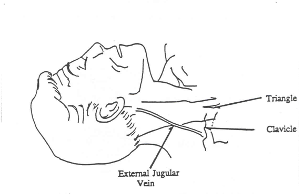Confirmation
PR13: External Jugular Cannulation
Applicable To
Introduction
External jugular cannulation is a vascular access option that allows for relatively large bore devices and the delivery of larger volumes of fluid than might otherwise be possible through a peripheral vein.
Indications
- A need for vascular access where peripheral access is not possible and intraosseous access is unavailable
Contraindications
- No absolute contraindications. This can be a time-consuming procedure; if speed is a requirement, consider PR12: Intraosseous Cannulation.
Procedure
- Place the patient in a supine, head-down position to fill the jugular vein. Turn the patient’s head to the opposite side (i.e., looking away from the proposed cannulation site).
- Clean the skin with alcohol.
- Align the cannula with the vein and the point of the needle aimed at the shoulder on the same side.
- While applying pressure to the vein above the clavicle to provide a tourniquet effect, make the venipuncture midway between the angle of the jaw and the clavicle.

Notes
Anatomy
The external jugular vein is formed below the ear and behind the angle of the mandible, where a branch of the posterior facial vein joins the posterior auricular vein. The external jugular vein then passes downward, and obliquely backward, across the surface of the sternomastoid muscle before piercing the deep fascia of the neck just above the middle of the clavicle, ending in the subclavian vein lateral to the anterior scalene muscle. Valves are present in this vein at the entrance to the subclavian vein and about four centimeters above the clavicle.
